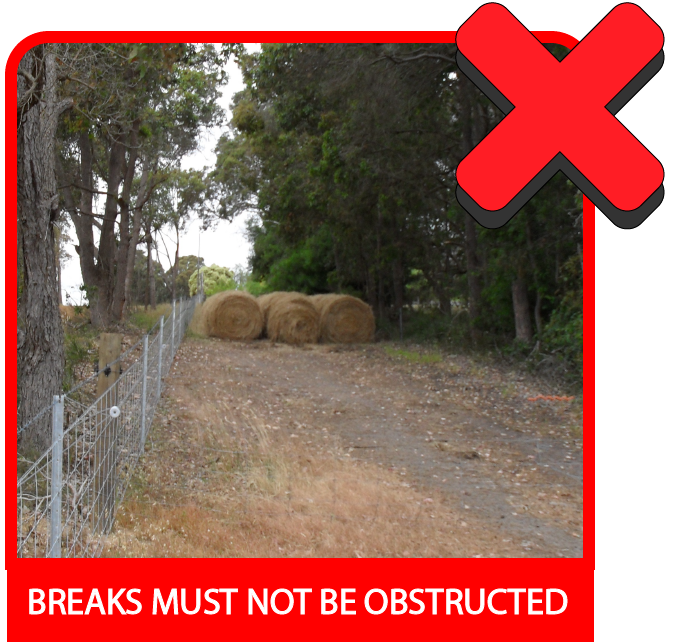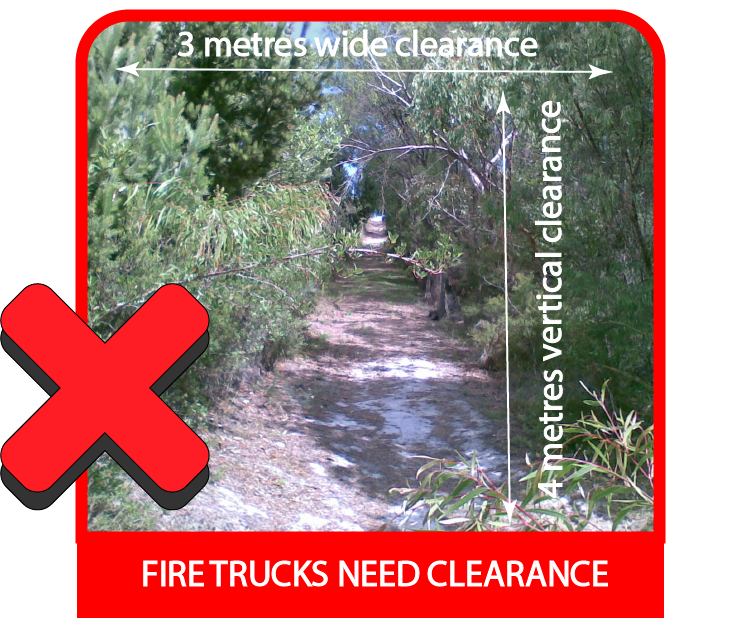Fire Management Notice Property Requirements
All land with total area less than 1000m2 (0.1ha)
The owner or occupier must reduce any fire hazard on their land by:
- Slashing, mowing or trimming all flammable* matter on the entire property (noting this does not include living trees, shrubs, plants and reticulated lawns under cultivation) to a height no greater than 50mm.
- Remove dead shrubs, plants and vegetation cuttings.swath across entire property
- Creating and maintaining Building Protection Zones*
See Definitions
All land with total area less than 4000m2 (0.4ha)
The owner or occupier must reduce any fire hazard on their land by:
- Reducing and/or maintaining fine fuel load* and/or ground fuel over the whole land to no greater than 50mm in height
- Creating and maintaining hazard specific fire breaks*
- Creating and maintaining building protection zones*
See Definitions
All land with an area 4000m2 (0.4ha) to 500,000m2 (50ha)
The owner or occupier must reduce any fire hazard on their land by:
- Creating and maintaining perimeter fire breaks*
- Maintaining fine fuel load* over all grassland to an average of eight (8) tonnes per hectare
- Creating and maintaining hazard specific fire breaks*
- Creating and maintaining building protection zones*
See Definitions
Non-Agricultural Non-Cropping Non-Stock Land over 500,000m2 (50ha)
The owner or occupier must reduce any fire hazard on their land by:
- Creating and maintaining perimeter fire breaks*
- Maintaining fine fuel load* over all grasslands to an average of eight (8) tonnes per hectare
- Creating and maintaining hazard specific fire breaks*
- Creating and maintaining building protection zones*
See Definitions
Agricultural Cropping and/or Stock Grazing Land over 500,000m2 50(ha)
The owner or occupier must reduce any fire hazard on their land by:
- Creating and maintaining perimeter fire breaks* are not compulsory but recommended
- Creating and maintaining hazard specific fire breaks*
- Creating and maintaining building protection zones*
- Cropping paddocks must be broken into compartments not exceeding 250 hectares in area, each separated by internal trafficable breaks.
See Definitions
Plantation Lots / Tree Farms
Owners and lessees of plantation lots / tree farms must comply with the Department of Fire and Emergency Services (DFES) Guidelines for Plantation Fire Protection (the guidelines) in addition to this fire management notice. The guidelines are available from the DFES website https://publications.dfes.wa.gov.au/.
Inspections and Compliance
The Notice constitutes the City of Albany Fire Management Notice pursuant to Section 33 of the Bush Fires Act 1954.
You are required to prepare and maintain your property for the fire season. The notice specifies the actions you must take on the land that you own and/or occupy, and with respect to any matter which is on the land that you own or occupy.
All fire mitigation measures must be in place by and maintained for the following periods:
| Northeast Sector |
01 October 2025 - 30 April 2026 |
| Southwest Sector |
01 December 2025 - 14 May 2026 |
City of Albany officers are authorised to enter and remain upon private property, without notice to the owner, to inspect and confirm compliance with this Notice. If you fail to comply with the requirements contained within this Notice, penalties under the Bush Fire Act 1954 may apply.
The owner or occupier of land who has received notice under Section 33(1) of the Bush Fires Act 1954 and who fails or neglects in any respect duly to comply with the requirements of the notice is guilty of an offence and liable to a fine of $5000.
Environmental Conditions
The requirement to clear a fire break under this notice exempts an owner or occupier from needing a permit to clear native vegetation under the Environmental Protection Act 1986 however it does not authorise an owner or occupier to carry out excessive clearing. Clearing or removal of native vegetation beyond the requirements of this notice will require permission from other State Legislative Authorities.
Any land subject to environmental value such as, but not limited to, Threatened Ecological Communities (TEC), Aboriginal sites as defined in the Aboriginal Heritage Act, Bush Forever Sites, Conservation covenant, Riparian vegetation or Declared Flora and Fauna should seek further information about what activities can or cannot be done prior to carrying out the requirements under this notice.
Owners and/or Occupiers must contact the relevant State Government agency which include but are not limited to: Department of Primary Industries and Regional Development, Department of Biodiversity, Conservation and Attractions, Department of Planning, Lands and Heritage, and Department of Water and Environmental Regulation.
Failure or neglect to comply with this notice is an offence and can result in a penalty of up to $5000.
City of Albany officers, servants, workers or contractors engaged by the City of Albany and any vehicles, appliances and machinery are authorised to enter and remain upon private property, without notice to the owner, to carry out the requirements of this notice that are not complied with by the date specified in this notice and any expenses, included court related costs, may be recovered from the owner and/or occupier of the property.
The City may vary a requirement or condition of this Notice at its discretion.
Any ‘variation to requirements’ approval you hold may be declared void at any time by the City.
If you have concerns about a property not being compliant during the fire season, please contact the City of Albany on 6820 3000 or "Report It" online.
Definitions
Perimeter Fire Breaks
Are a continuous (no dead ends) trafficable access track that has standard dimensions of 3 metres wide with 4 metres vertical clearance, located within 20 metres of the property boundary. It can be created by ploughing, cultivating, scarifying, burning or otherwise clearing including slashing and maintaining vegetation length below 50mm.
Hazard Specific Fire Breaks
Are a 3 metre low fuel area around flammable hazards with vegetation maintained below 50mm with no overhanging tree canopy. Includes but is not limited to; haystacks, non-dwelling sheds, green electricity power domes, electricity power poles and fuel storage areas.
Fine Fuel Load
Are grasses and other dead combustible vegetation matter up to 6mm in diameter. It does not include processed mulch below an average depth of 50mm.
A fuel load depth of 125mm (fine fuels) to the mineral earth is indicative of approximately 8 tonnes per hectare.
The more fuel load, the higher the flame height and increased fire intensity.
Ground Fuels
Are a leaf litter and scrub fuel, which is a combination of branches, twigs, sticks, seed pods and other woody materials, found on the ground in remnant bushland.
Flammable
Means accumulated fuel such as dry grass, leaf litter, twigs, branches, trash, bush, dead trees, firewood, stored fuels and scrub that can be easily ignited or is likely to catch fire and burn. It includes any other thing deemed by an Authorised Officer to be likely to catch fire but excludes living standing trees, growing bushes and plants in gardens and/or lawn areas under cultivation.
Building Protection Zone
Is a defendable space immediately adjacent to a building no less than three metres wide, clear of flammable vegetation and material.
Combustible objects, plants, garden supplies such as mulches should be avoided within 10 metres of the building and vegetation kept to a minimum and kept in a low fuel state.
From 10 metres to 20 metres of the building, land must be parkland cleared and in low fuel state. The building protection zone may reduce the likelihood and impact that direct flame contact, radiant hear or ember attack may have on buildings in the event of a bushfire.
Gutters, roofs and walls of all buildings to be free of flammable matter and maintained.
Trafficable
Means the capacity to allow a firefighting truck or other firefighting vehicle to safely navigate the interior perimeter of the property safely without impediment.
Fire Break Information
Fire Breaks
A continuous trafficable access track that has standard dimensions of 3 metres wide with 4 metres vertical clearance, located within 20 metres of the property boundary.
It can be created by:
- ploughing
- cultivating
- scarifying
- burning; or
- clearing, including slashing and maintaining vegetation length below 50mm.
Provisions of a trafficable area must be maintained for the duration of the fire season.



Hazard Specific Fire Breaks
Are a 3 metre low fuel area around inflammable hazards with vegetation maintained below 50mm. Includes but is not limited to; haystacks, non-dwelling sheds, green electricity power domes, electricity power poles and fuel storage areas.
Variation to Requirements of the Notice
The City recognises that in some instances, land owners or occupiers may not physically be able to meet all of the fire management measures listed in the Fire Management Notice.
If you cannot meet these Fire Management Notice requirements, you must apply for a variation or submit an approved Bush Fire Management Plan (BFMP).
Applications for variations must be submitted to the City of Albany by the 01 October 2025.
Variation Considerations
A variation may be considered for the following reasons:
- Property is steep and inaccessible and the installation of firebreaks or other fire mitigation measures would be dangerous or impractical.
- Areas of rocky outcrops or cap stone naturally reduces the fire risk or prevents fire breaks from being installed.
- Parts of the property is permanently water logged. (If only seasonally water logged, the Fire Management Requirements must be met as soon as the area has dried out sufficiently.)
- Clearing of vegetation is likely to impact upon areas of declared rare flora or environmentally sensitive areas as defined under the Environmental Protection (Clearing of Native Vegetation) Regulations 2004.
- Building positioning on block prevents the installation of an Building Protection Zone of the required size.
- For properties over 50ha that are bona fide agricultural operations:
- the grazing of stock that results in grassland being maintained at a height of 50mm or less;
- seasonal cropping that results in low fuel load being maintained. (Please note that the fire management requirements relating to Agricultural and Machinery Operations must be complied with.).
Where a variation has been approved, any special conditions that have been placed on the variation must be complied with. Any requirements stipulated in the Notice for which a variation has not been granted must still be met.
How to apply for a variation:
- Fill in a Variation to the Fire Management Notice (incomplete applications will not be processed.)
- Include a detailed, legible current map showing alternative fire mitigation measures
- Applications can only be made by land owners or by a person authorised to act on their behalf.
- The City will notify the applicant in writing of the outcome of the application.
- Where a fire management plan is provided as part of the application, it must be completed by an accredited Bushfire Planning and Design (BPAD) practitioner. Visit the Fire Protection Association (FPA) Australia at http://www.fpaa.com.au/bpad/practitioners.aspx to contact a BPAD practitioner.
- Applications submitted to City of Albany, North Road Administration Building or email [email protected]
Subsidiary Information to the Fire Management Notice
City Approved Treatment Plans
All properties and/or land subject to an approved Bushfire Management Plan (BMP) or an approved Bushfire Attack Level assessment (BAL), because of subdivision, development application or City approved treatment plan, must comply with the listed requirements and conditions in their entirety. Compliance with additional plans does not constitute compliance with this notice.
The City will only accept a BMP or BAL completed by an accredited Bush Fire Planning and Design Practitioner. A BMP can encompass single or multiple properties. All properties covered by a BMP or BAL must comply with all conditions of the BMP or BAL. Property owners and/or occupiers must still comply with all requirements in this notice and with ALL additional requirements outlined within the BMP, BAL or treatment plan.
To check your property zone and subdivision mitigation requirements please contact City of Albany Planning Services on 6820 3000 or email [email protected].
Useful Links & Documents